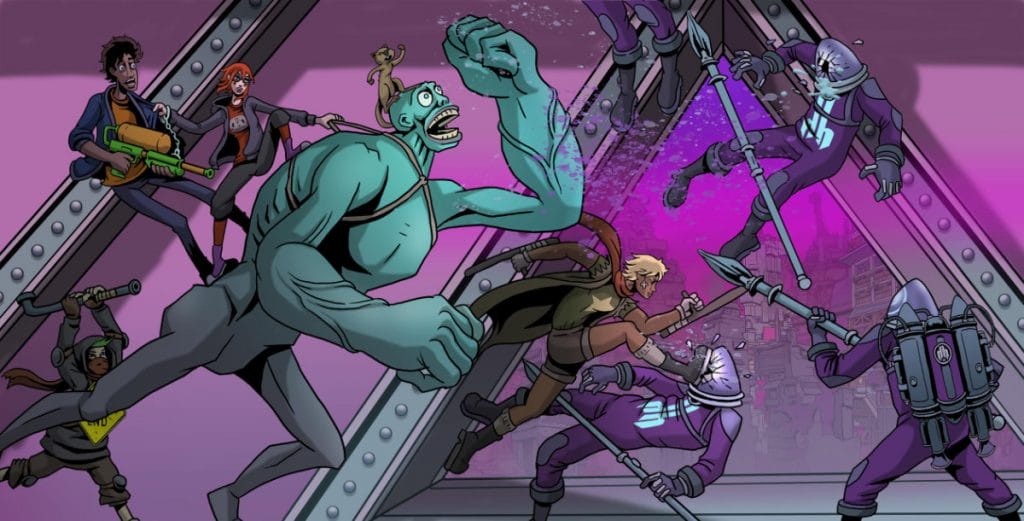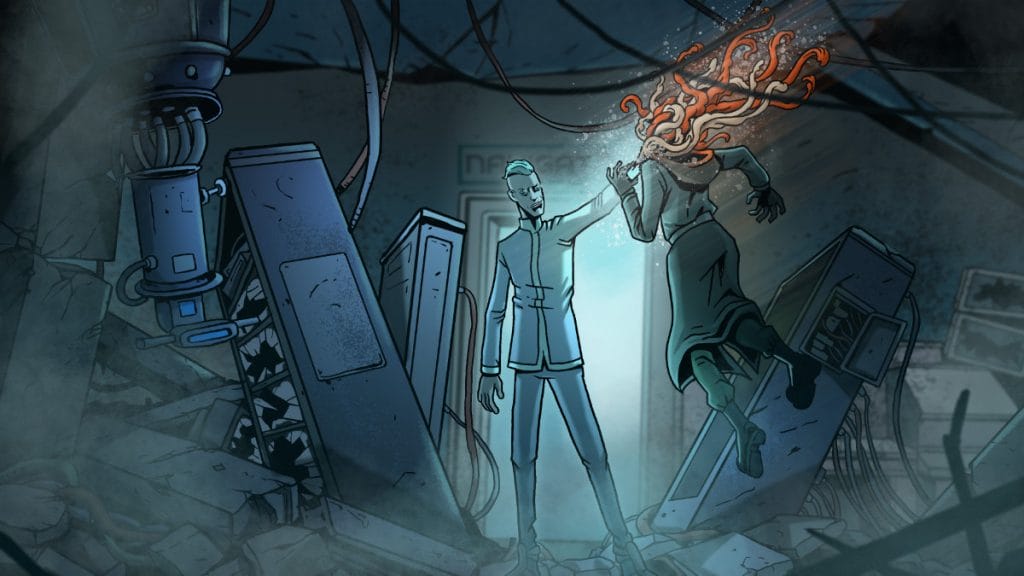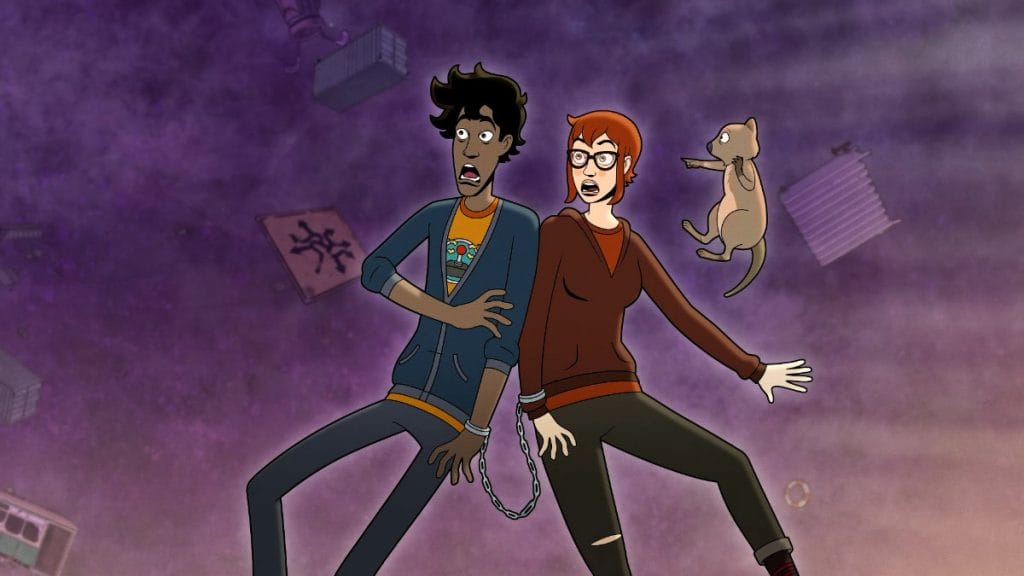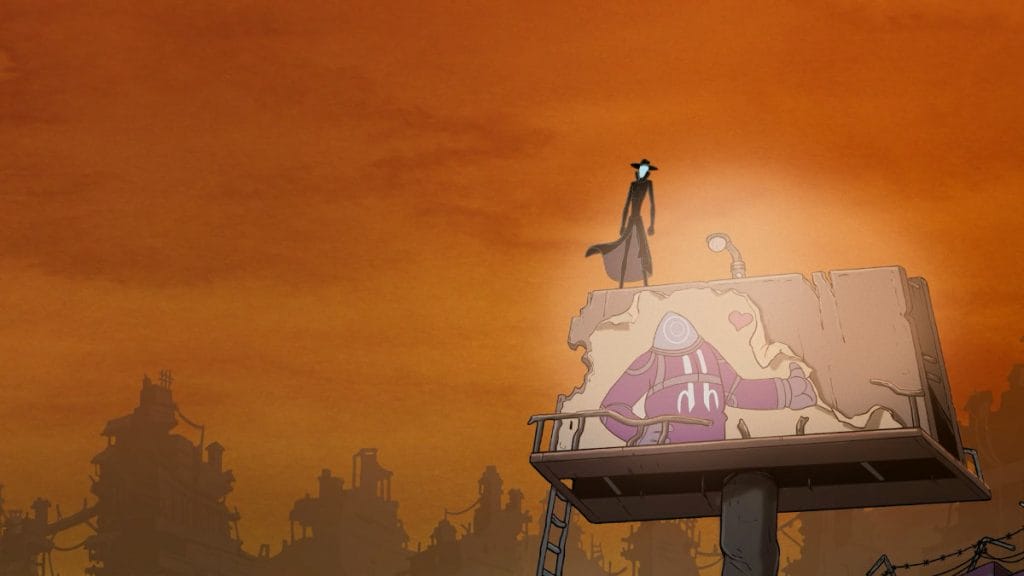Joy Eternal is an animation series from Fiilin Good Films targeted at a young adult audience. This unique series is co-produced with partners in Finland, Canada and Spain. The storytelling stands out with its blend of supernatural adventure, dark humour, and thought-provoking themes.
The story follows Joy, a young woman whose parents died while fighting a corrupt mega-corporation. Joy inherits their mission to take down the corporation. In a twist of fate, Joy awakens in the afterlife where she discovers that the corporation also controls the City of Lost Souls. She now seeks to dismantle the corporation from beyond the grave.
Throughout the production, the show’s international team used Storyboard Pro’s efficient pre-production workflows alongside Toon Boom Harmony’s robust animation tools. Together, they have crafted a visually stunning and emotionally resonant series which draws inspiration from a range of sources, including The Divine Comedy, Hellboy and Rick and Morty.
We had the privilege of speaking with Juha Fiilin (executive producer) and his team about their experiences creating this remarkable series. Read on for our full interview…
Please introduce Joy Eternal for our readers who aren’t yet familiar…
Juha: Joy Eternal is a young adult animation series created by Fiilin Good Films, based in Finland, and co-produced with partners in Canada and Spain. The story follows Joy, a young woman whose parents were taking down a corrupt mega corporation — Joy was in the wrong place at the wrong time and her both parents got killed.
Their last wish was that she’d enter a destructive code into the corporation’s servers. The mission is cut short when Joy dies accidentally, along with a young security guard named Oogle. Strangely, Joy wakes up in a mysterious afterlife and discovers that the evil corporation also runs the City of Lost Souls. She can still take them down with the kill code!

Who are the key team members behind the series?
Juha: The core team behind Joy Eternal includes:
Myself: Juha Fiilin, Director and Executive Producer (Finland). I developed the show’s concept over many years, shaping it into what it is today. I am passionate about creating stories that resonate with underrepresented audiences by showcasing diverse and relatable characters. In Joy Eternal, the protagonist learns that true self-worth is not derived from external validation but from inner recognition, which ultimately empowers her.
Adam Cullen, Head Writer (Ireland). Adam crafted the narrative and comedic elements of the series, creating memorable side characters such as the inept flying guards and paranoid resistance fighters. He explores themes of power and its illusory nature, reminding audiences that true strength comes from recognising one’s inherent value, independent of external successes or failures.
Jan Andersson, Art Director (Finland). Jan was responsible for the overall visual style, including the design of over 40 speaking characters and numerous locations. His background in animation and his work on the compositing of critical scenes were essential in bringing the series to life.
Benoit Godbout, Consulting Director (Canada). Benoit played a key role in refining the storyboards to a animation production-ready state and provided valuable insights for challenging scenes, particularly in action sequences. Among many other things he also fine-tuned a lot of the character expression and lip-sync design which contribute to the overall quality of the show.
Etienne Aubry, Animation Lead (Canada). Etienne is known for his work on Rick and Morty. He brought his expertise to the most complex walking and running cycles, poses and scenes, ensuring fluid animation throughout the series.

What are some of the biggest inspirations that went into your vision for Joy Eternal?
Juha: Joy Eternal was initially inspired by works like Dante’s Inferno and Hellboy, drawing on darker literary traditions. However, the series gradually evolved into a more unique vision of the afterlife, where a monstrous entity roams the void, capturing souls and transporting them to the City of Lost Souls. This blend of supernatural adventure, mystery, and comedy also includes elements of fantasy and sci-fi.
We drew early inspiration from shows like Rick and Morty for its adventure and humour, Avatar: The Last Airbender for its animation style, and Bojack Horseman for its blend of comedy and depth. As the series developed, other shows like What If…?, The Last Kids on Earth, and Kipo and the Age of Wonderbeasts became references for our approach.
Can you introduce your main characters and share the process of their design?
Juha: Certainly. The main characters include…
Joy: The headstrong protagonist on a journey of self-discovery. Throughout the series, she learns that true self-worth comes from within rather than from external validation, which ultimately empowers her and gives her super-natural powers.
Oogle: Joy’s loyal sidekick, who starts as a cowardly comic character but grows into a hero as he learns that the world can be more terrifying than Joy herself. He has two jackets, one of which holds the keys to the handcuffs that bind him to Joy, symbolising their shared fate.
Herb: Joy’s emotional support quokka, who can transform into a powerful magic quokka. Herb adds comic relief while aspiring to be a hero in his own right, despite her cuteness.
The design process began with developing a motion comic series around Joy, which was then refined to adapt to the rigged character animation. Each character’s design reflects their narrative arc and role in the series, blending gritty, utopian, and surreal aesthetics.

What three words would you use to describe the art style of Joy Eternal, and why?
Juha: Gritty: The show’s visual approach captures the dark, dystopian elements of the story, reflecting the harsh realities of the world Joy navigates.
Vibrant: Despite the darker themes, bursting bold colors and dynamic visuals bring the afterlife to life, making it feel engaging and captivating.
Cinematic: The animation features strong framing and pacing, with a focus on visual storytelling and dynamic movement, giving it a film-like quality.
How did you convey themes of corporate dystopia in your backgrounds and environments?
Juha: In the afterlife, Joy finds herself in the Void, eventually landing inside a monster’s belly — home to the City of Lost Souls, which is controlled by the mega-corporation. The city is constructed from materials pulled from the Void, such as remnants of vehicles and structures from people’s past lives — trains, airplanes, trailers, cars, ski-lifts, and more.
This eerie, patchwork city represents the decay and corruption of the corporate dystopia that Joy must dismantle. Jan Andersson led the design process, which took several years to fully develop before production, ensuring every detail aligned with the series’ themes.

What tools in Storyboard Pro and Toon Boom Harmony did you find useful in the production?
Juha: Storyboard Pro’s video export feature was invaluable, allowing us to start the editing process early in pre-production with rough animatics to visualise pacing and flow. In Toon Boom Harmony, we relied heavily on rigged characters and hand-drawn effects. The software’s flexibility allowed us to recycle effects by adjusting colours, outlines, and textures, streamlining the animation process while maintaining consistency across episodes.
Can you share a particular challenge from the making of Joy Eternal, and how it was overcome?
Juha: Pre-production was particularly challenging due to the complexity of the story and the scripts, which featured multiple storylines, numerous locations, and a large cast of speaking characters, all within a limited episode length.
The storyboard process was demanding, especially since the team had mostly worked on children’s animation. Therefore I draw thumbnails for each shot of each episode to guide the process. The lack of full-time Storyboard revisionists led to shot angle inconsistencies, causing delays due to additional work for the art department.
The animatic editing phase was also under-resourced, requiring me to take on the editing myself as it was crucial to nail comedic timing and action sequences. With approximately 250 shots per 11-minute episode, keeping the edits tight was a challenge. Layout faced similar issues, with limited resources leading to work that needed extensive corrections in post-production. Despite these hurdles, we managed to achieve the desired outcome by investing more time in post-production.

What are the key considerations when creating young adult animation for audiences in different countries?
Juha: One key consideration is the use of language. Nordic young adults are accustomed to natural, unfiltered dialogue, which often includes swearing. However, our Canadian co-producer and sales company requested that we soften the language, leading to focus group feedback indicating the show felt suited to a younger audience than initially intended. Additionally, we softened action scenes involving fighting, kicking, and punching, which further contributed to the series skewing towards a younger demographic.
What advice would you give animators embarking on adult animation projects?
Juha: I would advise animators to pay close attention to detail and aim for more realistic character portrayals, whilst boosting poses and expressions when dealing with non-realistic characters or situations. Adult animation often demands a higher level of complexity across all departments, from storytelling to character design, to effectively resonate with a more mature audience.

What’s next for Fiilin Good Films?
Juha: We at Fiilin Good Films are excited about the future as we gear up to produce a diverse slate of projects that showcase our commitment to creative and innovative storytelling across various genres and formats. We’re expanding into kids animation with Tunda & Onyx, a Jamaican series that emphasises friendship, respect, and equality while highlighting the island’s unique culture.
Additionally, we’re venturing into much scarier story with Just Us, an anime-inspired series that explores complex themes like cognitive impairment and altered reality. Our lineup also includes Brother’s Keeper a feature-length dark comedy that humorously tackles the subject of euthanasia through a magical escape from death, and Happy?, an animated sitcom that blends humour with cultural commentary as a Finnish family tries to sabotage their country’s celebrated happiness record.
Furthermore, we’re exploring darker themes in the thriller series Brainwash; set in a dystopian society divided by privilege, and we’re bringing action to the forefront with the anime-inspired feature film Orphan Yakuza which follows young orphan criminals fighting the futuristic Tokyo gangland’s super-human gangsters, while a young girl wants to save them, but how do you save lost boys who have no home to go to? This ambitious lineup reflects our dedication to broadening our portfolio with daring and culturally rich stories that resonate with diverse audiences.
Please note that the project names are still code names as they are works in progress.
- Interested in learning more about Joy Eternal and Fiilin Good Films? Be sure to visit Fiilin Good Films website.
- Ready to get started on your next animated project? Artists can download a free 21-day trial of Toon Boom Harmony.
The post Fiilin Good Films on animating the afterlife in Joy Eternal appeared first on Toon Boom Animation.
Courtesy: https://www.toonboom.com/fiilin-good-films-on-animating-the-afterlife-in-joy-eternal






